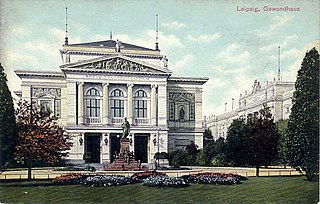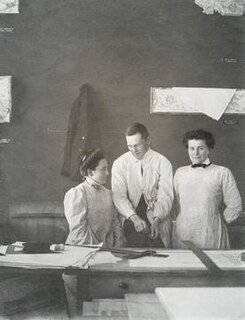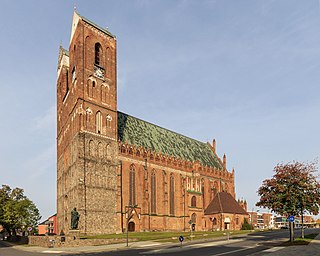Related Research Articles

Potsdam is the capital and largest city of the German state of Brandenburg. It directly borders the German capital, Berlin, and is part of the Berlin/Brandenburg Metropolitan Region. It is situated on the River Havel some 25 kilometres southwest of Berlin's city centre.

Charlottenburg is a locality of Berlin within the borough of Charlottenburg-Wilmersdorf. Established as a town in 1705 and named after late Sophia Charlotte of Hanover, Queen consort of Prussia, it is best known for Charlottenburg Palace, the largest surviving royal palace in Berlin, and the adjacent museums.

Babelsberg is the largest district of Potsdam, the capital city of the German state of Brandenburg. The affluent neighbourhood named after a small hill on the Havel river is famous for Babelsberg Palace and Park, part of the Palaces and Parks of Potsdam and Berlin UNESCO World Heritage Site, as well as for Babelsberg Studio, a historical centre of the German film industry and the first large-scale movie studio in the world.

Martin Carl Philipp Gropius was a German architect.

The Marmorpalais is a former royal residence in Potsdam, near Berlin in Germany, built on the grounds of the extensive Neuer Garten on the shores of the Heiliger See (lake). The palace was commissioned by King Friedrich Wilhelm II and designed in the early Neoclassical style by the architects Carl von Gontard and Carl Gotthard Langhans. The palace remained in use by the Hohenzollern family until the early 20th century. It served as a military museum under communist rule, but has since been restored and is once again open to the public.

Johann Heinrich Strack was a German architect of the Schinkelschule. His notable works include the Berlin Victory Column.

Gerhardine "Gerdy" Troost, was a German architect interior designer and interior decorator and the wife of Paul Ludwig Troost.

Babelsberg Palace lies in the eponymous park and quarter of Potsdam, the capital of the German state of Brandenburg, near Berlin. For over 50 years it was the summer residence of Prince William, later German Emperor William I and King of Prussia and his wife, Augusta of the House of Saxe-Weimar-Eisenach, German Empress and Queen of Prussia.

Liane Zimbler, née Juliana Fischer, is said to be the first European woman to obtain an architecture degree, although a number of Finns, including Signe Hornborg, graduated much earlier. After running a highly successful business in Vienna, Zimbler emigrated to the United States in 1938 where she specialized in interior design.

Thekla Schild was a German architect. In 1913 she became the second woman in Germany to earn a degree in architecture.
Marie Frommer, was a Polish-born German architect. Her work reflected the principles of Expressionism and the Neue Sachlichkeit, emphasizing colour and experimenting with light and form.
Feministische Organisation von Planerinnen und Architektinnen is an organisation working to address gender issues in the built environment generally and among professionals active in this field.

Agathe Lasch was a German philologist. She was the first female professor of German studies in Germany, and the first female professor at the University of Hamburg. She founded the historical study of the Middle Low German language. As a Jew, Lasch was murdered during the Holocaust.
Despina Stratigakos is a Canadian-born architectural historian, writer, vice provost, and professor of architecture at the University at Buffalo.
Adelheild Gnaiger (1916–1991) was an Austrian architect. She studied at the Vienna Institute of Technology, now TU Wien, graduating in 1937. After working in an office in Zurich, she took her licensing exams in 1950 to found her own office. She was the first woman to head her own architectural practice in Vorarlberg. Her office worked on civic and private commissions, including banks, schools and public buildings. She was the architect of the ... and also designed of a number of private residences. Her architecture, defined by a style that negotiated between modern architecture and tradition, influenced the architecture of Vorarlberg in the post-war period. Her life and work was the subject of Ingrid Holzschuh's book Adelheid Gnaiger. Die erste Architektin Vorarlbergs with contributions by a number of notable Austrian art historians. The book was published in collaboration with the vorarlberg museum.

Elisabeth von Knobelsdorff was a German engineer, and architect.
Clara von Simson was a habilitated natural scientist, German politician (FDP) and a member of the Berlin House of Representatives.

Lotte Cohn (1898-1983) was a German Israeli architect and pioneer in the development of Israeli architecture.

The Marienkirche in Prenzlau, Brandenburg, Germany, is the main Protestant parish church in the town, and is one of the most ornate churches of the Brick Gothic style in northern Germany. The church is a listed building.
Ingeborg Kühler is a German architect, engineer and university lecturer. She was the first female design professor at a West German architecture faculty and designed the plans for the Technoseum in Mannheim, Baden-Württemberg, Germany.
References
- "Emilie Winkelmann" Archived 2011-05-25 at the Wayback Machine , Berlinische Galerie. Retrieved 9 February 2012.
- "Frauenorte Brandenburg | Emilie Winkelmann". www.frauenorte-brandenburg.de. Retrieved 2016-03-08.
- Stratigakos, Despina (December 2007). "The Professional Spoils of War: German Women Architects and World War I" . Society of Architectural Historians. Journal of the Society of Architectural Historians (66.4): 468. Retrieved December 25, 2018.
- Stratigakos, Despina (December 2007). "The Professional Spoils of War: German Women Architects and World War I" . Society of Architectural Historians. Journal of the Society of Architectural Historians (66.4): 468. Retrieved 25 December 2018.
- Stratigakos, Despina (December 2007)."The Professional Spoils of War: German Women Architects and World War I" . Society of Architectural Historians. Journal of the Society of Architectural Historians (66.4): 473. Retrieved 25 December 2018.
- "Winkelmann, Emilie", Berliner Bezirkslexikon. (in German) Retrieved 9 February 2012.
- "Emilie Winkelmann, Architektin" Archived 2014-01-10 at the Wayback Machine, Lexikon: Charlottenburg-Wilmersdorf von A bis Z. (in German) Retrieved 9 February 2012
- "Tribüne", Berlin Charlottenburg. (in German) Retrieved 9 February 2012.